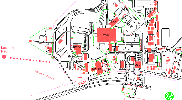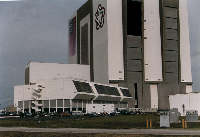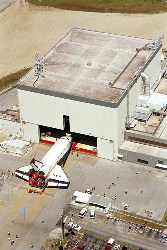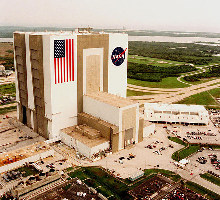 |
Discovery
will begin it's journey in a spectacular rush of light
and sound. For a few brief moments, lift off will turn
night into day along Florida's space coast. |
Kennedy
Space Center Press Site
|
|

The
Press Site is the center for all news activities at Kennedy
Space Center (KSC). It includes a 350-seat, covered grandstand
with electrical and telephone service, a 90-seat auditorium
for press conferences and briefings, and an audiovisual laboratory.
The major television networks and other media have permanent
facilities at the Press Site on land leased from NASA.
The
Press Site is located in the Launch Complex 39 Area, just
south of the Vehicle Assembly Building (VAB) and Launch Control
Center (LCC). It is adjacent to the Barge Terminal Facility,
commonly known as the Turn Basin. Located just 3 miles (3.22
Kilometers) from the Shuttle pads, it is an excellent location
for viewing a launch.
 |
 |
|
Press
area map
|
Kennedy
Space Center 3D overview map
|
What
you can see from the Press Site:
WebCam
Views
The
Shuttle Launch Pads
More
Pad Facts
Launch
Control Center (LCC)
Orbiter
Processing Facility (OPF)
Vehicle
Assembly Building (VAB)
More
VAB Facts
Operations
Support Building (OSB)
The
Shuttle Launch Pads
 The
twin Space Shuttle launch pads, formally known as Pad 39-A
and Pad 39-B, are just three miles from the Press Site. They
were originally designed to support the Apollo program and
later modified for Space Shuttle launch operations. Major
changes included the erection of a new Fixed Service Structure
(FSS), addition of a Rotating Service Structure (RSS), and
the replacement of the Saturn flame deflectors with three
new flame deflectors. The two pads are virtually identical
and roughly octagonal in shape. The
twin Space Shuttle launch pads, formally known as Pad 39-A
and Pad 39-B, are just three miles from the Press Site. They
were originally designed to support the Apollo program and
later modified for Space Shuttle launch operations. Major
changes included the erection of a new Fixed Service Structure
(FSS), addition of a Rotating Service Structure (RSS), and
the replacement of the Saturn flame deflectors with three
new flame deflectors. The two pads are virtually identical
and roughly octagonal in shape.
More
Pad Facts:
- The
distance between the pads is 2,657 meters (8,715 ft).
- The
Sound Suppression Water System is used to protect the launch
structure from the intense sound pressure of liftoff. Its
water tank is 88.9 meters (290 ft) high and has a capacity
of 1,135,000 liters (300,000 gallons).
- The
height of the Fixed Service Structure (FSS) is 105.7 meters
(347ft) to the top of the lightning mast (referenced to
the pad base) and the Rotating Service Structure (RSS) is
57.6 meters (189ft) high.
- The
Fixed Service Structure (FSS) and Rotating Service Structure
(RSS) on Pad 39-A underwent a renovation between June and
September 1993. Workers applied 13,773 gallons (52,130.805
liters) of paint in two coats, and the sandblasting operation
used 1866 tons of sand.
- The
Weather Protection System protects Shuttle tiles from wind-blown
debris, rain and hail. Between the Shuttle's belly and the
external tank, wheeled metal doors slide to within 3 inches
(7.62 centimeters) of each other, providing protection for
the lower part of the Shuttle.
- Approximately
1.25 million feet (381,000 meters) of tubing and piping
reside at Launch Complex 39. They vary in size from .25
inches (.635 centimeters) to 114 inches (289.6 centimeters)
in diameter. This is enough pipe to reach from Orlando to
Miami.
Launch
Control Center
 The
Launch Control Center (LCC) is a four-story building that
is the electronic "brain" of Launch Complex 39. Attached to
the southeast corner of the Vehicle Assembly Building (VAB),
it is 5,535 meters (18,159 ft) from Pad 39A. At the time it
was constructed, advances in electronics had made it unnecessary
to continue locating blockhouses adjacent to launch pads.
The LCC houses the four firing rooms from which the launches
are controlled. The
Launch Control Center (LCC) is a four-story building that
is the electronic "brain" of Launch Complex 39. Attached to
the southeast corner of the Vehicle Assembly Building (VAB),
it is 5,535 meters (18,159 ft) from Pad 39A. At the time it
was constructed, advances in electronics had made it unnecessary
to continue locating blockhouses adjacent to launch pads.
The LCC houses the four firing rooms from which the launches
are controlled.
Orbiter
Processing Facility
 |
Immediately
after landing, the Shuttle is towed to the Orbiter Processing
Facility (OPF), located west of the Vehicle Assembly Building
(VAB). The facility includes three garage-like hangars
that the Shuttles enter horizontally. After a Shuttle
return to Earth, this is where the processing team removes
residual fuels and explosive materials. Then they remove
the mission payloads, inspect the vehicle, test and refurbish
it for its next flight. These activities take up about
two-thirds of the Shuttle processing time between missions.
The remaining third is for installing and checking out
the next mission's payload. |
Vehicle
Assembly Building
 The
Vehicle Assembly Building (VAB) is one of the largest buildings
in the world. It was originally built for assembly of Apollo/Saturn
vehicles and was later modified to support Space Shuttle operations.
High Bays 1 and 3 are used for integration and stacking of
the complete Space Shuttle vehicle. High Bay 2 is used for
external tank (ET) checkout and storage and as a contingency
storage area for Shuttles. High Bay 4 is also used for ET
checkout and storage, as well as for payload canister operations
and solid rocket booster (SRB) contingency handling. The
Vehicle Assembly Building (VAB) is one of the largest buildings
in the world. It was originally built for assembly of Apollo/Saturn
vehicles and was later modified to support Space Shuttle operations.
High Bays 1 and 3 are used for integration and stacking of
the complete Space Shuttle vehicle. High Bay 2 is used for
external tank (ET) checkout and storage and as a contingency
storage area for Shuttles. High Bay 4 is also used for ET
checkout and storage, as well as for payload canister operations
and solid rocket booster (SRB) contingency handling.
To
build the Space Shuttle "stack", workers hoist SRB segments
onto a Mobile Launcher Platform and mate them together to
form two complete SRBs. The Shuttle's external tank arrives
by barge, is inspected and checked out, and attached to the
SRBs already in place. The Shuttle is then towed over from
the Orbiter Processing Facility to the VAB, raised to a vertical
position, lowered onto the Mobile Launcher Platform, and mated
to the rest of the stack. When assembly and checkout is complete,
the crawler-transporter picks up the platform and assembled
Shuttle vehicle and carries them to the launch pad.
More
VAB Facts:
- The
VAB covers 3.25 hectares (8 acres).
- It
is 525 ft (160 meters) high. This is 220 ft (67 meters)
taller than the Statue of Liberty, which stands 305 ft (93
meters) tall.
- It
is 716 ft long (218 meters) and (518 ft) 158 meters wide.
Not counting the end zones, a football field is 300 ft long.
- It
encloses 3,665,013 cu meters (129,428,000 cub ft) of space.
The VAB has the volume of 3.75 Empire State Buildings.
- The
flag on the side of the VAB is 209 x 110 ft (64 x 33.5 meters).
If a tour bus could defy gravity, it could easily drive
inside the width of each stripe.
Operations
Support Building (OSB)
The
Operations Support Building (OSB) is a six-story, office building
that contains technical documentation center, a library, and
the photo analysis area.
Back
to Top
|